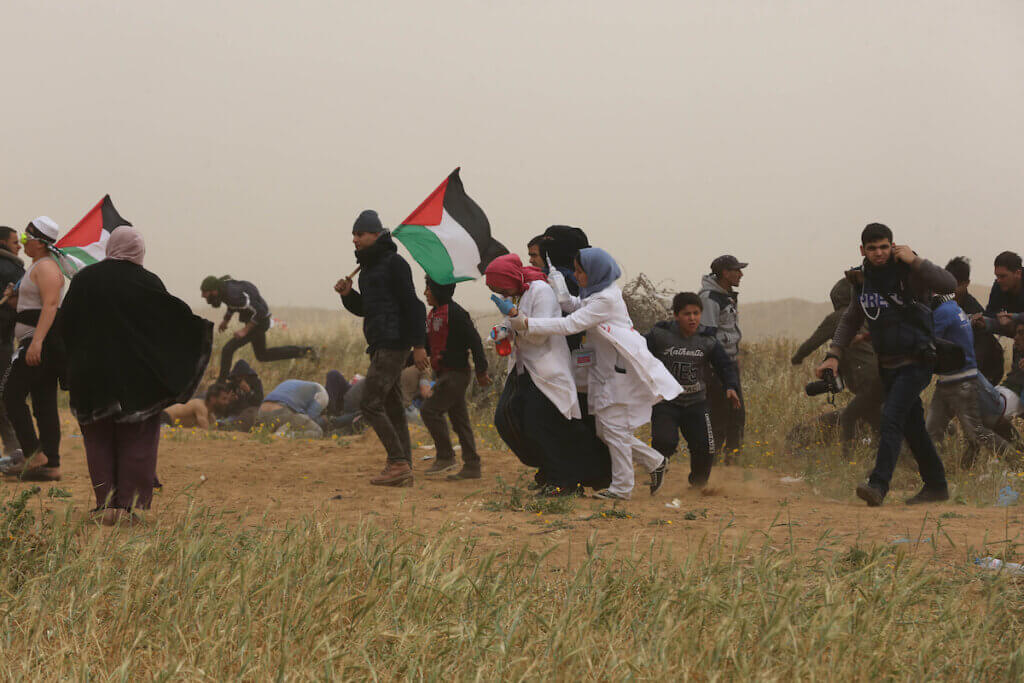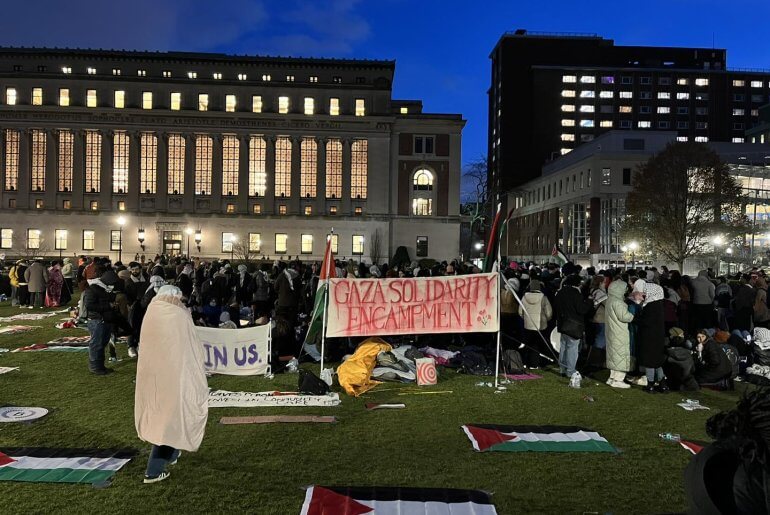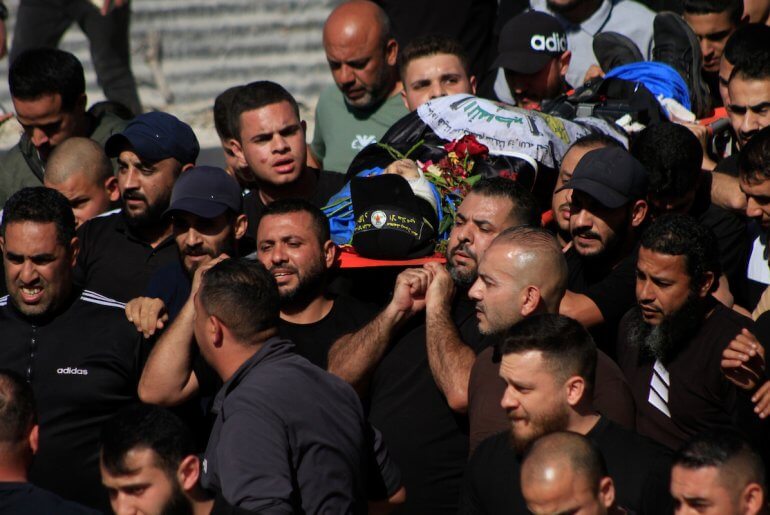Slowly and carefully, 32-year-old Saed Qaddoum moves about his home on a crutch. He plants his foot on the ground on one side while moving forward with his crutch on the other. His other leg dangles suspended above the floor, missing a part of itself.
Saed lost his foot five years ago during the Great March of Return. He has had 27 extensive surgeries done on his foot in the hopes of keeping it. He was eventually forced to amputate it lest he lose his entire leg. Saed isn’t the only person in his family who was injured during the Great March. His brother, 34-year-old Mohammed, suffered the exact same injury. His foot was amputated as well. Both of their lives have been unalterably changed since they joined the mass protests that emerged on Gaza’s borders in 2018.
The Israeli response to these protests was as aggressive as it was deliberate. Protesters were shot with explosive bullets — what is known as a “high explosive incendiary” designed to pierce armor and cause maximum damage to the target — at the protesters’ feet, eyes, head, and chest. This led to an uncommonly high number of amputations resulting from the wounds systematically and intentionally inflicted on dozens of protesters.
Despite the life-changing impact of these wounds, Saed and Mohammad say they would do it all again because the Great March of Return was also life-changing.
“If the protests resume again, we will be in the front lines,” Saed says, considering his continued participation a duty in service of Palestinian liberation. “We were motivated by the idea that these marches would bring us closer to returning to our homeland beyond the Israeli fence,” he says. “We could see our lands on the horizon and believed we would be able to reach them.”
The Great March of Return started on March 30, 2018, and ended on November 23, 2019. During this period of time, Israel killed 316 people and injured over 35,703, according to Gaza’s Ministry of Health (MOH) report. Many of these injuries were to the feet, to about 9,389 people, leading to 158 amputations. Many more were to the head and neck, the upper and lower limbs, and the chest and back.

‘I lost my foot to liberate our homeland. I’m ready to give my life’
When the Great March of Return first started, minivans fitted with speakers drove all over Gaza, calling on people to participate in the event. Government buses were also parked outside the mosques every Friday, moving people after Friday prayers to the border fence, where the protests were due to take place.
“Our belonging to our homeland, our sacred places, our religion…these were the only motivation for me to participate in the Great March of Return,” Saed says. “I joined the protests from the beginning, and I went to the borders daily.”
In June 2018, three months after the first march, Saed was injured in both feet. One of the injuries was critical. His brother Mohammed was injured two months later.
“My only goal in participating was to free our land,” Mohammad tells Mondoweiss. “We were going to the borders and looking at our beautiful lands that lay just behind the Israeli soldiers. We had faith that we could cross.”
But Saed believes now that his dreams did not come true because they could not cross the borders nor free their lands.
“We did not reach Jerusalem, our occupied capital,” he says bitterly.

While the Great March of Return didn’t achieve the liberation to which the protesters aspired, asked if they would do it all over again, Saed and Muhammed say they wouldn’t blink. They rush to add that if the Great March were to be reactivated, they would join in a heartbeat.
“I lost my foot to liberate our homeland. I’m ready to give my life for this goal, for my future children to live in a free homeland,” Saed says.
The purpose of the Return March was simple in its essence: it aimed to send a message to the world that Palestinians are still longing to return to the homes and lands that Zionists occupied in 1948. The message was a repudiation of Oslo and an unambiguous affirmation of the Right of Return. What’s more, the organizers of the March weren’t going to wait around for someone to give it to them — they were going to exercise it themselves. Hundreds of thousands amassed at the borders, so close to the lands their ancestors once inhabited. Israel’s bullets stopped them.
“These protests were peaceful marches to tell the world that it’s time for the Palestinian people’s occupation to end, so they can live in dignity in an independent and free state,” Mahmoud Khalaf, member of the National Commission for the Great March of Return, tells Mondoweiss.
Khalaf confirms that the marches achieved many goals, especially in imparting the March’s political message to the world. “We expect that the world will move to fulfill international and United Nations pledges,” he says, adding the caveat: “but until now, the world is biased in Israel’s favor and has not taken any real step in supporting the Palestinian people in gaining their rights.”
‘The objective was to cause critical damage.’
Mahmoud Khalaf
The protests were one form of the Palestinian struggle against the occupation, says Khalaf, affirming that Palestinian resistance can take on many forms so long as the goal of delivering a message to the world is fulfilled. That’s what Khalaf believes the Great March of Return did.
All forms of struggle are on the table, Khalaf says. “But Palestinians will not accept the will of the occupation. They will hold onto all forms of struggle,” he adds.
The Israeli occupation used the language of power when dealing with the Return March. It maimed most but also doled out field executions — all of them protesters that posed no real danger to Israel.
“Israel targeted sensitive areas in the protesters’ bodies, including direct shots to the eyes, feet, and arms,” Khalaf says. “The objective was to cause critical damage.”

‘I had to leave a part of my body behind’
Before he was wounded, Saed had a job that brought in a decent income that could support his family. He could also move freely. The injury changed his life. “Now I can’t go out, I can’t work, I can’t leave my home,” he says. Usually only leaving home for emergencies, he sometimes goes for short walks using his crutches when the boredom becomes suffocating. “Everything’s changed now,” he says.
‘I woke up in the hospital, and started my journey of suffering’
Saed Qaddoum
“I was raising the Palestinian flag and standing at the front lines of the protest when I was shot and knocked down,” he recalls. “I woke up in the hospital and started my journey of suffering.”
Saed’s injury had caused critical damage to his left foot’s bones, tendons, and arteries. He lost 20 centimeters of bone.
“A British delegation was observing my case,” he says. “They told me that my wound was critical and that surgery won’t help. They told me directly: there is no chance of walking normally again.”
Saed decided to go through surgery anyway, hoping to get his life back. But eventually, his foot’s color turned black and blue. His liver was damaged from all the infections. “The doctors insisted that I have to choose amputation.”
For Saed, that was the toughest call to make. “I had no time to think twice. I had to leave a part of my body behind.”
Saed consoled himself by telling himself that he wasn’t the only one: “I told myself there are people who have lost their lives for liberation. I would only lose a foot, that’s nothing. That gave me some relief.”
After four years of medications battling the prospect, he finally made the decision to go through with it.
“It was really hard on me, I can’t even describe how I felt,” he tells Mondoweiss. “I started to get flashbacks of my life before the injury, and then started to imagine how life will become after losing my foot,” he says.
Saed used to work as an electrician, usually making about 70 NIS a day. After the amputation, he’s unable to work in any field.
Saed got married and started a family after his injury. He is expecting a child soon.
But the injury didn’t only hurt his work prospects. It even changed his social life, affecting his close circle of friends. “I used to have friends from every place, we used to visit each other very often,” he says. “Now I find my company with people like me who lost their feet in the March of Return. They support me and keep telling me that we are in better condition than other people who were paralyzed from the neck down.”
Saed joined a football team made up of amputees. This helped him reenter society. “I lived through a dark after the injury,” he says. “I thought that my life had ended. I thought that because I was disabled, nothing would work for me. I felt that I lost myself,” he says. His family supported him and kept encouraging him to engage with society. He eventually did.

“I loved my life, my work. I loved how I could move quickly and freely. But this lifestyle has changed me forever. Thinking about how my life was before was killing me,” he says.
The role his family played in his recovery was instrumental. His new friends who shared the same condition were also indispensable. They would meet him at the rehabilitation center and kept calling on him to invite him to participate in social events they held as a group.
“Everyone was telling me that I shouldn’t allow the occupation to win through my surrender,” he says. “That was enough to wake me up.”
Tareq S. Hajjaj
Tareq S. Hajjaj is the Mondoweiss Gaza Correspondent and a member of the Palestinian Writers Union. He studied English Literature at Al-Azhar university in Gaza. He started his career in journalism in 2015 working as news writer/translator at the local newspaper Donia al-Watan. He has reported for Elbadi, Middle East Eye, and Al Monitor. Follow him on Twitter at @Tareqshajjaj.




My father lost his right leg when it was amputated due to thrombosis. Like Saed it had a devastating affect on him. But unlike Saed he was fitted with an artificial leg. When he couldn’t manage with the artificial leg he was provided with a wheelchair. When he wanted to go further afield he was able to have an electric chair.
I am so in awe of Saed and the other amputees Tareq describes, their only means of mobility are crutches, and yet they persevere, they encourage one another, they strive to lead as normal a life as possible. They go on to marry and start a family. I’ve even seen reports of amputees competing in football matches, rushing around the pitch on their crutches as if they were able bodied.
The Palestinian “Samud” is truly amazing in the face of all the brutality, oppression, and injustice they are forced to endure.
“These protests were peaceful marches to tell the world that it’s time for the Palestinian people’s occupation to end, so they can live in dignity in an independent and free state”.
______________________________________________________
Is that two states or one? Placards and cameras could help “tell the world”.